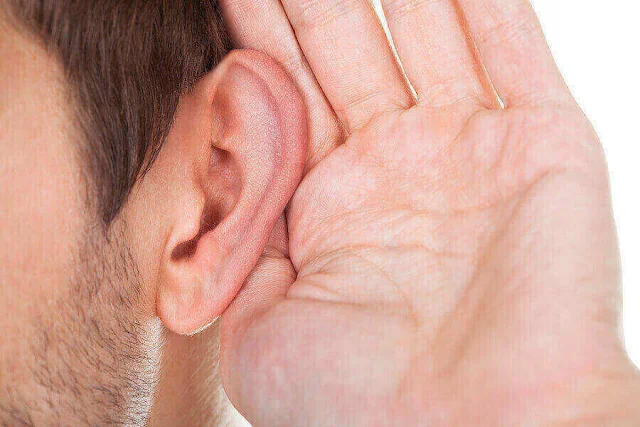Definition: It means diminution of hearing up to complete loss, in other words: it is total or partial inability to hear sounds.
Types: There are Organic and Hysterical causes of deafness, Organic typre is classified into 3 sub-categories as discussed below.
I. Organic: A: Conductive. B: perceptive (SNHL). C: mixed.
II. Hysterical.
A. Conductive hearing loss
It means interference of sound transmission along the conductive apparatus (External & middle ear).
Causes:
I. Causes in the External Auditory Canal (EAC):
- Congenital: meatal atresia or stenosis.
- Trauma: Foreign body or traumatic acquired atresia.
- Inflammatory: large furuncle, Diffuse OE, Otomycosis, polyp.
- Neoplastic: Large exostosis – malignant tumors.
- Miscellaneous: wax buildup (the commonest cause).
II. Causes in the Tympanic membrane:
- Traumatic: rupture of T. M.
- Inflammatory: bullous myringitis.
III. Causes in the Middle Ear:
- Congenital: middle ear atresia or hypoplasia, ossicular fixation or deformity.
- Traumatic: Ossicular dislocation – barotrauma - Longitudinal temporal bone fracture
- Inflammatory: - Acute suppurative otitis media - CSOM - Chronic non suppurative otitis media.
- Neoplastic: Glomus tumors, Carcinoma.
- Miscellaneous: Otosclerosis, Tympanosclerosis.
IV. Causes in Eustachian tube:
- Congenital: cleft palate.
- Traumatic: post adenoidectomy scarring, barotrauma.
- Inflammatory: tubal catarrh.
- Neoplastic: nasopharyngeal tumors.
- Miscellaneous: hypertrophy of the adenoid.
B - Sensorineural hearing loss
It means defect in conversion of sound energy to electrical impulses (cochlea) or transfer of impulses along cochlear nerve & central connections to auditory cortex.
I. Cochlear Causes (Sensory):
a. Congenital: Hearing loss dating since birth or shortly after.
1. Hereditary due to genetic aberrations:
- If Deafness alone:
Michael’s: total lack of inner ear development.
Mondini’s: partial aplasia of labyrinth cochlea makes 1 ½ turns.
- If Deafness with other abnormalities:
Usher’s Syndrome: SNHL + retinitis pigmentosa.
Pendred’s Syndrom: SNHL + goitre.
Alport’s Syndrome: SNHL + nephritis.
2. Prenatal:
- Maternal infections as rubella in the 1st trimester.
- Drug intake in the 1st trimester e.g. quinine, aminoglycosides and salicylates.
3. Natal: (during labour):
- Hypoxia or anoxia of the fetus.
- Birth trauma as in forceps delivery.
4. Postnatal:
- Neonatal infections.
- Erythroblastosis foetalis (Rh incompatibility).
b. Traumatic
- Transverse fracture of temporal bone involving the labyrinth.
- Labyrinthine membrane rupture(perilymph fistula).
- Acoustic (noise) trauma.
c. Inflammatory (Labyrinthitis)
1- Infective:
- Viral: measles, mumps, influenza, the deafness occurs after the febrile stage. It may be unilateral or bilateral, asymmetric and affects more the high tones.
- Syphilitic labyrinthitis: deafness is progressive, asymmetric and may be associated with vestibular symptoms (i.e. Vertigo).
- Bacterial: - Labyrinthitis secondary to suppurative otitis media, Meningitis: deafness is bilateral and profound.
2- Toxic:
- Ototoxic drugs: quinine, aminoglycosides, salicylates, and Lasix.
- Metabolic: uremia, diabetes, thyrotoxicosis.
d. Vascular
Internal auditory artery occlusion due to spasm, thrombosis or embolism.
It causes sudden hearing loss (treated by large dose of steroids).
e. Miscellaneous
- Presbycusis (senile deafness).
- Meniere’s disease.
- Pure cochlear otosclerosis.
- Perilymph fistula.
II. Retrocochlear causes
Due to lesion either in the vestibulocochlear nerve, or in the auditory pathway.
1- Vestibulocochlear nerve affection:
A- Cerebellopontine angle lesions as in acoustic neuroma, and congenital cholesteatoma.
B -Meningitis.
C-Vascular loop.
2 - Central: due to lesion anywhere in the auditory pathway. It is rare.
A-Multiple sclerosis.
B-Meningitis, encephalitis.
C- Brain tumours.
D-Cerebrovascular accidents e.g. thrombosis, haemorrhage or embolism.
C - Mixed Hearing Loss
1- Congenital meatal atresia with inner ear anomaly.
2- Fracture base of skull.
3- Complicated CSOM with labryinthitis.
4- Combined otosclerosis i.e. (footplate fixation, cochlear otosclerosis).
